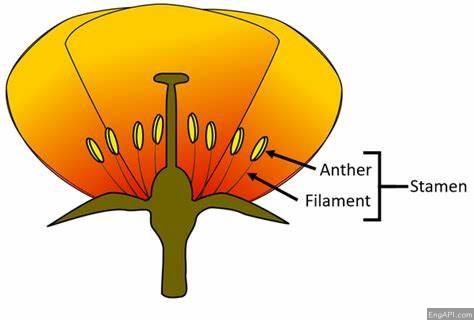

stamen
音标:
英音/ ˈsteɪmən / 美音/ ˈsteɪmən /
听听基本释意:
外刊例句:
The rest is up to you, pistils and stamens.
其余的取决于您,雌蕊和雄蕊。
—Washington Times
As Malinda, my two nieces and I walked through the Tucquan Glen last weekend, broad white rhododendron blooms with pink stamens brushed our shoulders.
作为马林达(Malinda),我和我的两个侄女上周末走过图昆·格伦(Tucquan Glen),宽阔的白色杜鹃花盛开,粉红色的雄蕊刷了我们的肩膀。
—New York Times
The plant grows delicate white flowers with yellow stamens and lily pads as small as one-third of an inch across.
植物用黄色的雄蕊和小的小垫子长到三分之一英寸。
—New York Times
基本释意:
noun
the male reproductive organ of a flower
[植]雄蕊
同义词:
没有找到同义词
短释义:
In many flowers, you can easily see the stamens—or more precisely, the parts of the stamen called filaments, the thin stalks in the middle of the bloom, and the anthers, the tiny pods that hold the pollen. In Latin, stamen means “foundational warp thread in weaving,” and its root means “to stand, or make firm.”
雄蕊是产生花粉的花的一部分,因此可以繁殖。大多数花中的雄蕊数量与花瓣的数量相同。
长释义:
In many flowers, you can easily see the stamens—or more precisely, the parts of the stamen called filaments, the thin stalks in the middle of the bloom, and the anthers, the tiny pods that hold the pollen. In Latin, stamen means “foundational warp thread in weaving,” and its root means “to stand, or make firm.”
在许多花朵中,您可以轻松地看到雄蕊,或更确切地说,雄蕊的部分称为细丝,花朵中间的细茎以及花药,握持花粉的小豆荚。在拉丁语中,雄蕊的意思是“编织中的基础翘曲线”,其根源是“站立或变得坚定”。
文学例句:
Both showed plentiful yellow stamens in the centres, and had exquisite rich dark leaves.
两者在中心都表现出大量的黄雄蕊,并具有精美的深色叶子。
—Old-Time Gardens
Newly Set Forth by Earle, Alice Morse
Exotic crimson flowers and birds poked their pistils and stamens and bills every which way up and down her torso.
异国情调的深红色花朵和鸟儿戳了他们的雌蕊和雄蕊,并在她的躯干上下张开了每一条费用。
—How the García Girls Lost Their Accents by Julia Alvarez
The stamens are very numerous, and are spirally arranged; and the carpels are variable in number, sessile or stipitate and slightly united at the base and dehisce by ventral suture.
雄蕊非常多,并且在螺旋上排列。地球的数量是可变的,无柄或粘性的,并且在底部略有融合,并通过腹侧缝合线脱落。
—Encyclopaedia Britannica, 11th Edition, Volume 13, Slice 2
“Hearing” to “Helmond” by Various
词源:
stamen(n.)”pollen-bearing organ of a flower,” 1660s, from Modern Latin (1625, Spigelus), from Latin stamen “stamen” (Pliny), literally “foundation in weaving, thread of the warp” in the upright loom (related to stare “to stand”), from PIE *sta-men- (source also of Greek stēmōn “warp in the upright loom,” also used by Hesychius for some part of a plant, Gothic stoma, Sanskrit sthaman “place,” also “strength”), from root *sta- “to stand, make or be firm.” The usual English plural is stamens because of the special use of the classical plural, stamina (q.v.).also from 1660s
下面是词源的翻译(机器翻译比较难翻,参考着看)
stamen(n.)”pollen-bearing organ of a flower,” 1660s, from Modern Latin (1625, Spigelus), from Latin stamen “stamen” (Pliny), literally “foundation in weaving, thread of the warp” in the upright loom (related to stare “to stand”), from PIE *sta-men- (source also of Greek stēmōn “warp in the upright loom,” also used by Hesychius在植物的某些部分,哥特式造口,梵文Sthaman“位置,也是“力量”),从根 *sta-“站立,制造或坚定”。通常的英语复数是雄蕊,因为经典复数,耐力(QV)。也从1660年代开始
本站没有存储任何书籍、杂志和报纸。
页面内容只做展示和推荐。如果您喜欢本期内容请购买正版。
This site does not store any books, magazines or newspapers.
The contents of the pages are for display and recommendation only.
If you like the content of this issue please purchase the original.